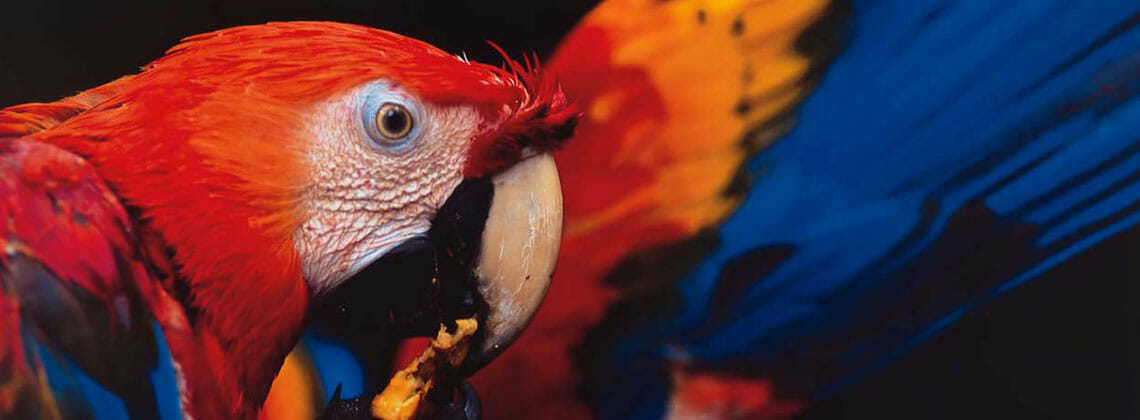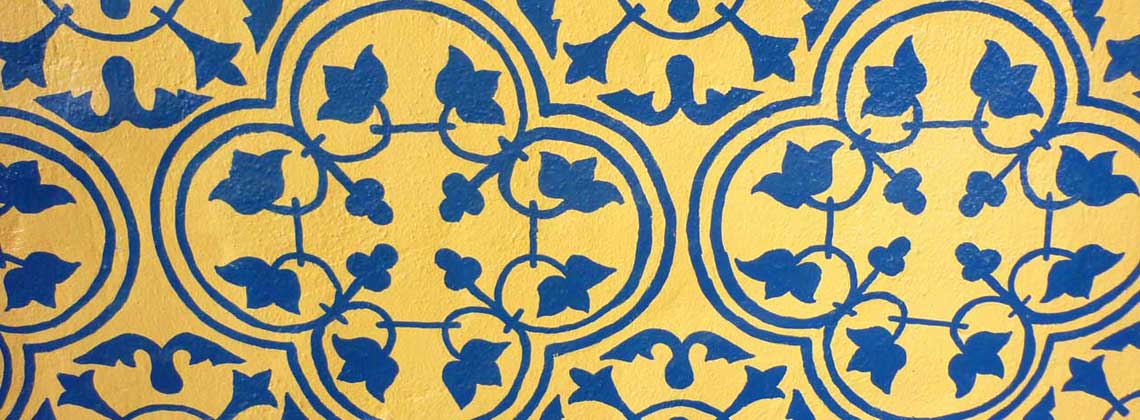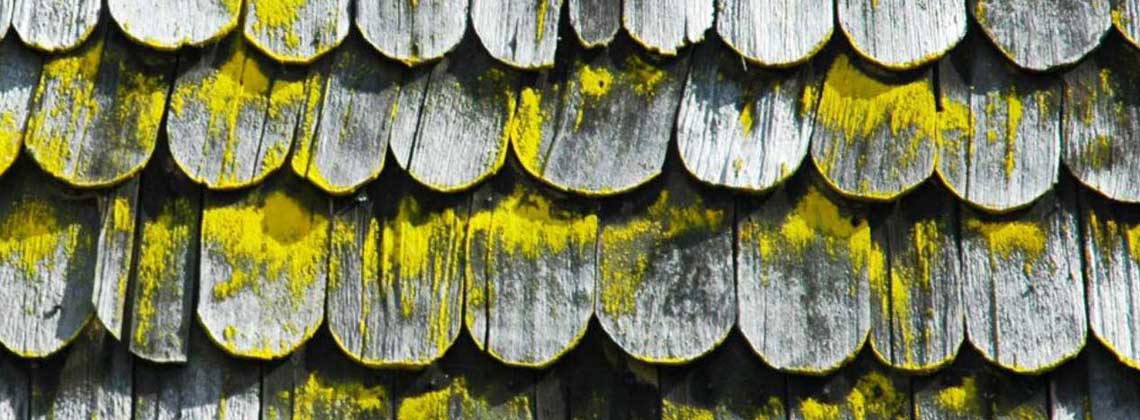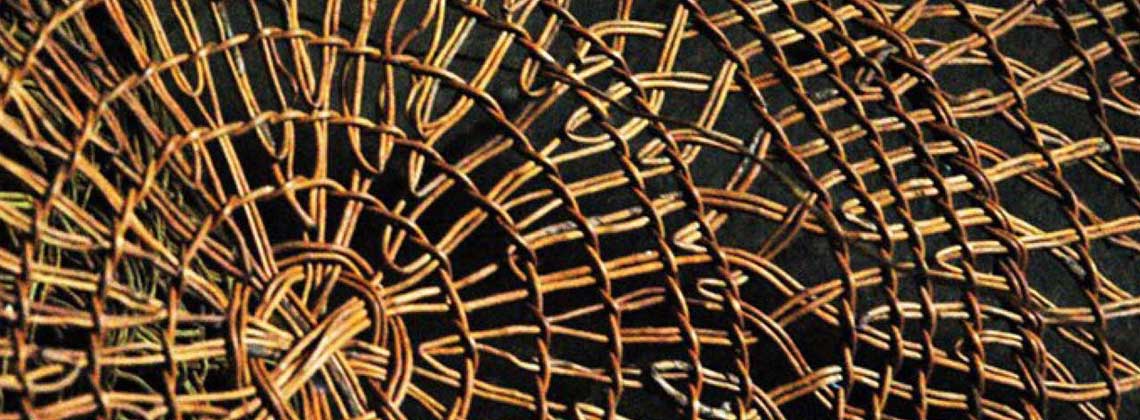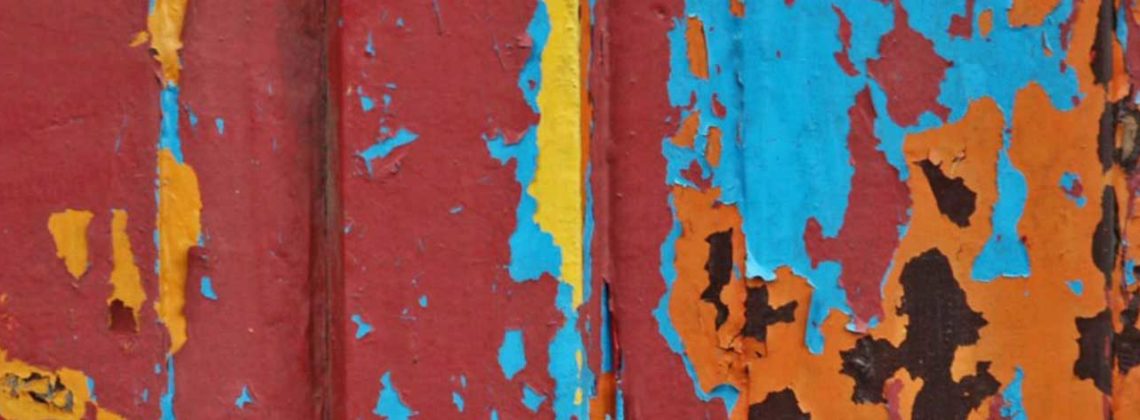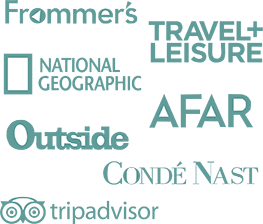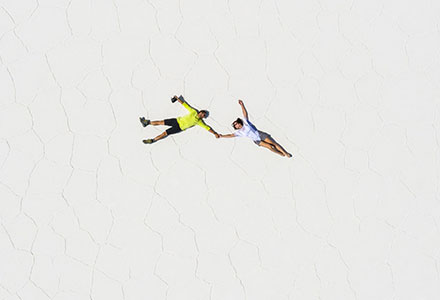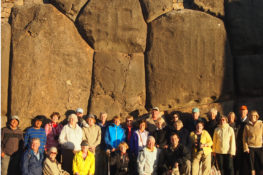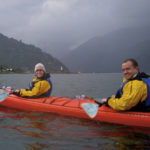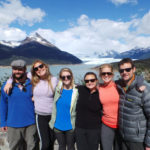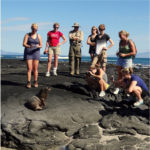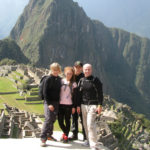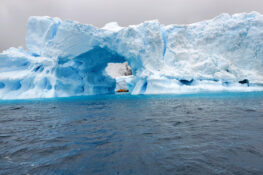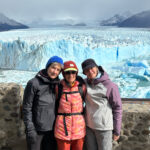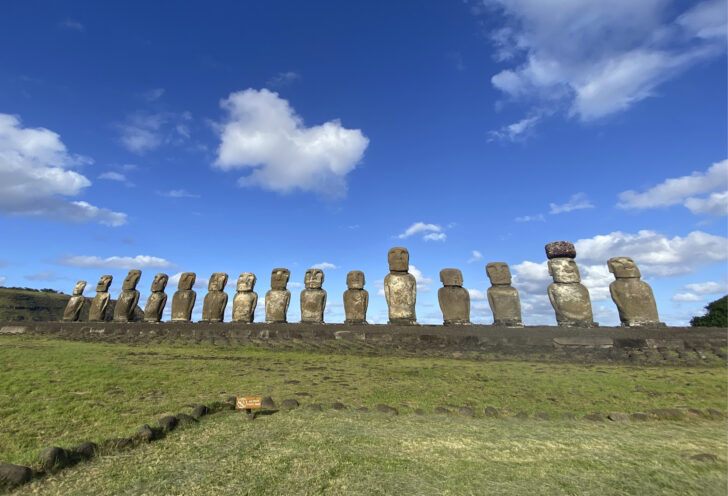
While working with clients, it’s not uncommon for a traveler to tell me they’ve had a lifelong interest in visiting Easter Island, known as Rapa Nui in the local language. Whether it was spurred by Leonord Nimoy’s In Search of episode from 1977, a grade school project, or a recent friend’s trip, the fascination that this tiny, remote island can instill is deep and strong. Ever since visiting the island nearly 20 years ago, I’ve felt a consistent draw to return. On this recent trip, I went deeper into the archaeological sites, culture, and accommodations. This blog shares my insights to help you discover the magic of the island in a personalized and smooth way.
The Draw of Easter Island
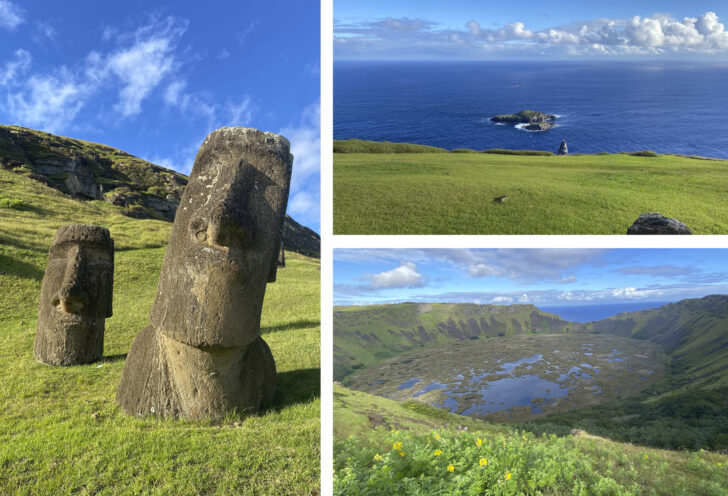
The imposing and impressive stone Moai statues, carved directly from the island’s volcanic rock, represent what drives the interest in visiting this remote piece of land: the mystery and fascination behind how these massive structures were created and moved into place. Who were the people behind them? How did this colossal effort just suddenly stop at some point long ago?
It’s an extremely remote island. In fact, the International Space Station passes overhead on occasion, and when it does, anyone in it is closer to you on the island than anyone back on the Chilean mainland, 2,200 miles away.
This is a piece of land that resulted from the activity of three major craters and many smaller ones, now only 14 miles long and 7 miles wide. As a natural wonder, its rocky shores, lava-crafted caves, tucked-away beaches, and the incredible, expansive 360-degree views of the Pacific give it a whole other set of appeal beyond the archaeological legacy.
It’s also a testament to the ability of people to survive in far-off places, with a community of locals that share in many of the customs and feel of other Polynesian islands throughout the Pacific.
This combination of archaeological intrigue, remoteness, culture, and raw natural beauty is what makes trips to Easter Island so special.
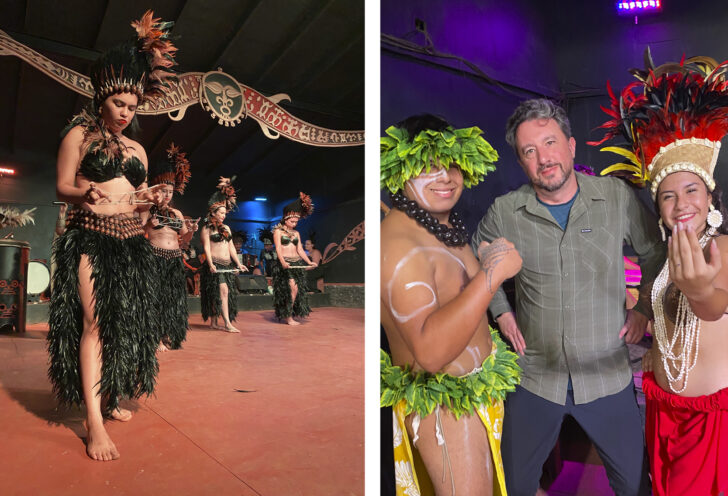
Who should visit Easter Island?
Easter Island is a great fit for travelers who have an interest in the archaeological history of its inhabitants, Polynesian culture, and the story behind the impressive and mysterious Moai. For me, this came to life in the visits to the ritual sites, where I learned about the ancient Birdman competition and attended some Polynesian dance shows — a nice mix of the old and the contemporary.
Surprising to many, Easter Island is also a great place for those looking for active adventures. The rolling hills of the island make it a great place for biking. Mountain biking in particular, with rides to the caves, to the highest point in the mountain or just as a means of getting about to different sites, is a great way to experience the island. The rides can be largely road-based, or get off-road for some moderate climbs and downhills.
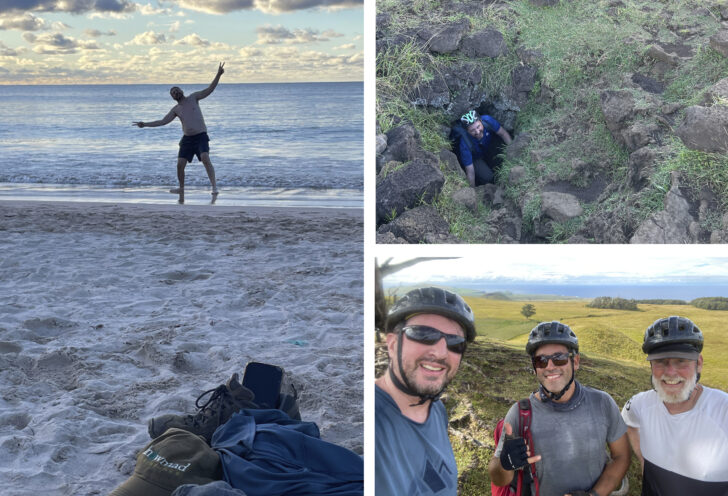
For fans of trekking, the constant scenery of craters and sea views makes it a superb place for a hike as well.
For those who enjoy scuba diving or snorkeling, it’s also a great place to work in one of these activities. Although there are only two small beaches, it can also be a nice, relaxing visit with some time to soak in the sun.
If you are more interested in just the culture, history, and the Moai, then I find that three nights is usually sufficient to visit the main sites and have some time to enjoy and relax. If your interest extends to the active elements, then it’s best to add on a fourth night so you’re able to visit the main sites as well as work in some active adventures.
Getting to Easter Island
There are at most two flights a day, but many days it’s only a single round-trip flight from Santiago on LATAM Airlines. On average, the flight time is just under 5 hours and 30 minutes, but this can vary depending on the winds. Remember that the time zone is also two hours behind Santiago and Chile’s mainland.
Flights usually depart around 9 a.m. arriving at noon island time, and return to Santiago that same day, leaving the island between 2-4 p.m. island time, and arriving back to Santiago between 9-11 p.m. mainland time. You need to arrive at the airport at least two hours before departure, so you are best being in Santiago the night prior to your departure flight, and need a night on the back end as well. Therefore, for a three-night stay on the island, you need to consider five nights between the Santiago portion and the time on the island.
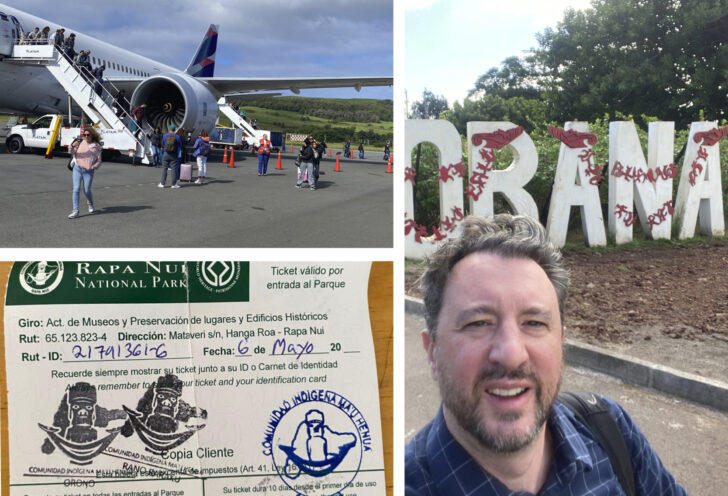
Regulations and Logistics
There is a bit more red tape for visiting Rapa Nui than other parts of Chile. Being a small island, there are tight measures to control the influx of people. You must have a confirmed hotel stay and confirmation letter from a government-approved accommodation. This information is submitted to authorities in a form along with a signed declaration that you don’t intend to stay. This is then checked prior to departure at the Santiago airport.
Once on the island, there are a few other restrictions. To access nearly all of the Moai sites, which are part of a national park, you must not only have a park pass but also a certified guide or a Rapa Nui resident with you. There are a few exceptions, such as the Tahai site just outside of town, where I enjoyed a couple of sunsets on my trip.
How to fit Easter Island into a trip?
Easter Island can work as a standalone trip that combines with a night or two in Santiago and Central Chile. I’d suggest starting with at least one day in Santiago, and then perhaps adding a day visit or a night or two in Valparaíso or wine country after the visit.
It also adds a strong contrast to another region like Patagonia in a longer, two-week trip. Easter Island pairs nicely with the Atacama too, a good option for travelers who have visited Patagonia and are considering returning to see these other highlights. Either of these makes for a mind-bending combination of landscapes and cultures.
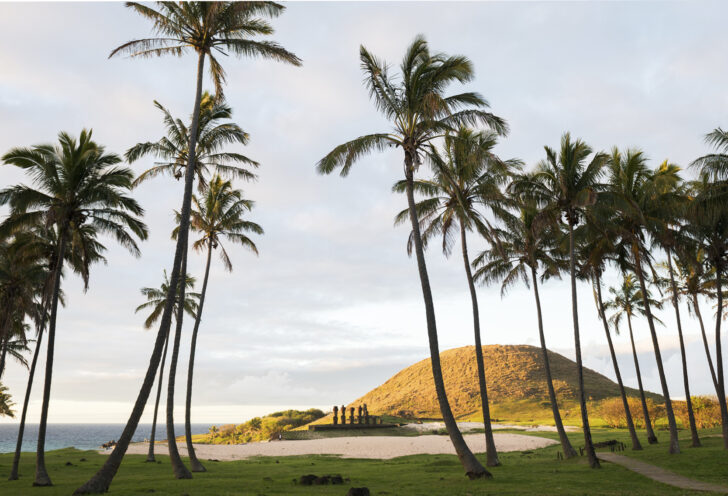
When to Travel?
Easter Island is largely temperate year-round. It does get more rain between June and August, but it’s still possible and enjoyable to make the visit then. The seasonality of lodging, high-season rates, and increased visitors in October through March, tends to respond more to the outside factor of the mainland summer season (also when Patagonia and Southern Chile is more hospitable).
The annual cultural festival of Tapati falls during the first two weeks of February. This features all sorts of events like competitions that showcase the Polynesian culture, music, games, races, and more. Prices are higher and it’s much busier.
Where to stay on Easter Island
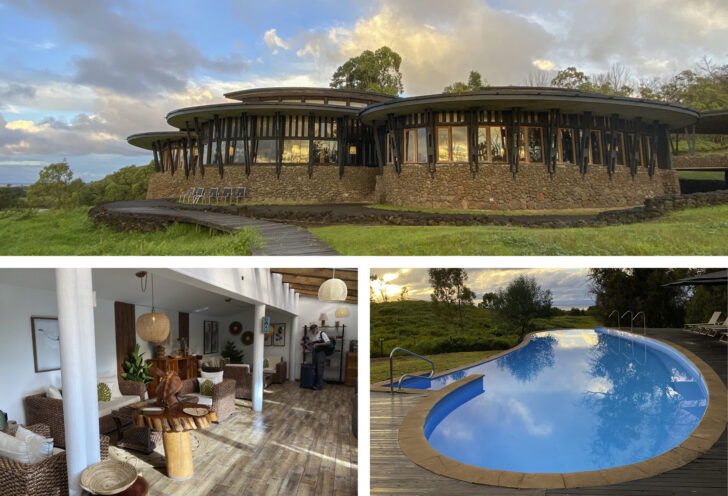
Choose your lodging based on your interests, budget, and expectations for spending time in the only town on the island. The top lodging options are inclusive adventure properties, which include all of your guided excursions and meals. For those that are OK with a bit less fancy lodging and would prefer privately guided excursions, B&B style properties can be ideal. I’ll outline both of these options below.
All-Inclusive Adventure Lodges on Easter Island:
Explora Rapa Nui
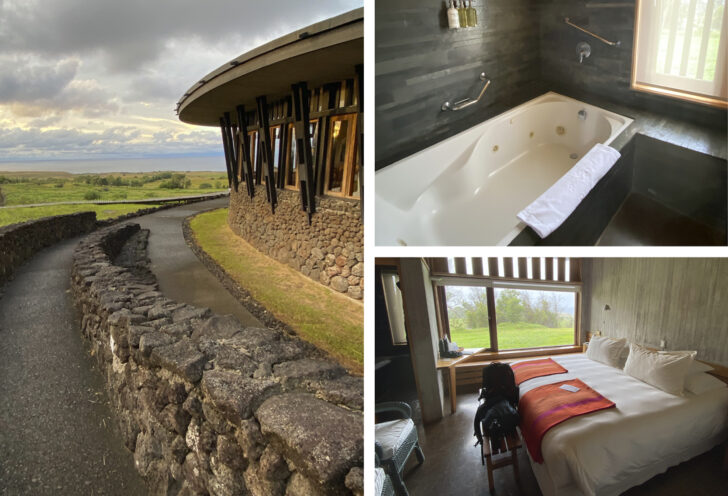
Explora Rapa Nui is the nicest stay on Easter Island. Situated on a hill about 25 minutes drive outside of town it has a panoramic view towards the sea. I loved the sunrise from this location. The hotel has a spectacular design, featuring nice common areas with the full arrangement of spa, pool, restaurant, and bar. In terms of activities, they have a nice set of excursions that allow you to visit the main ritual sites and Moai, as well as a great active approach, mountain bike routes, horseback riding, options for snorkeling or scuba diving, and more.
There are two categories among their 30 rooms, a high staff-to-guest ratio, and an incentive program that applies if you are combining your stay here with other Explora lodges. It is also the highest-cost lodge. During the October through March high season, a three-night stay totals $3,270 per person as of the 25/26 season.
Drawbacks to this choice? It is not accessible to get to town. They have group excursions which are tightly organized in terms of timing. They don’t offer any stargazing options nor anything specific for the sunset. It has an in-house Polynesian show that they put on, but it’s a much simpler version than you get in town.
This is a great fit for those who want top-tier lodging and who appreciate the flexibility of the inclusive program. It provides you with excursions that focus on the history of the island and the active adventures possible here. It’s also a fit for those who don’t mind being in a more remote location and are ok with the cost and the shared group excursions.
Nayara Hangaroa
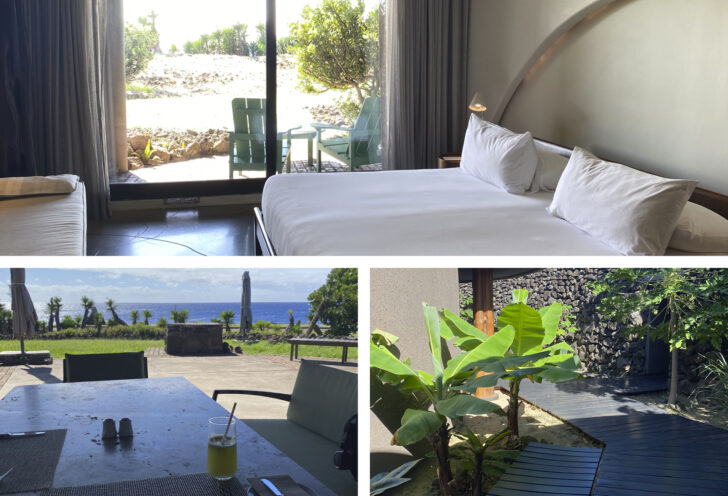
This is another top-tier choice for the island. It’s a larger place, with two categories and 70 rooms. Rooms are spacious, have a nice bathtub and outdoor sitting area. It’s on its own little piece of land and only 15-20 minutes walk into town. In order to cover the highlights of the island, they are always offering four half-day excursions that, over the course of two days, will get you to all the must-sees.
They also have trekking and biking options, or can give you bikes or quads to take out on your own. I’m always a fan of riding out on my own, and their specialized mountain bikes looked to fit the bill perfectly. It also has a pool, spa, restaurant, bar and a nice cozy venue for Polynesian shows, which are similar to the ones offered in Hanga Roa.
The drawbacks of this choice? They do have outside events using the space and restaurant, and you’ll have to sign for every last coffee, drink, and meal — even if it’s included. Common areas have a sea view, but only a few rooms actually have an unobstructed view. The cost here is also significant, coming in just under $3,000 per person for a three-night stay during the 25/26 high season. They do have a promo reducing the cost by 25% for those staying four nights or more.
This is a good fit for travelers who are looking for a flexible inclusive program and want all the amenities of a luxury hotel. It’s great for those who want this but also want easier access to the town of Hanga Roa, or want some flexibility to do some self-guided rides. They do have a regular bed & breakfast program, so it can be a lodging choice along with an outside private guide as well.
Top Easter Island Hotels/B&Bs
Hare Uta
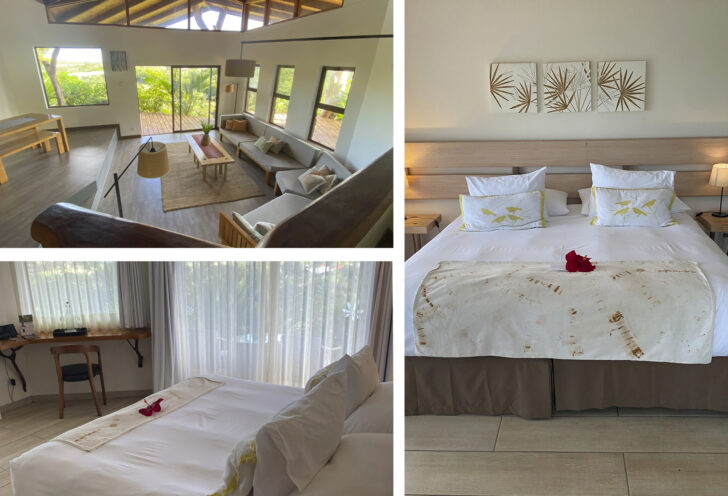
This beautiful property features lush grounds and gardens, great decor and touches throughout the property. With only 9 rooms as of this writing, it’s a small, exclusive property. It has a small but beautiful pool, and a spa area with extra services. Rooms are spread across three buildings, with every 2-3 rooms having a shared common living room area. Rooms are spacious, with ample showers and balcony space. I particularly love a good restaurant with a fire pit in the middle, as they have here, and the setting is full of charming details and art.
The drawback to this choice? The location is far enough from the center of town that you’ll need to arrange transportation to and from, which can be more challenging in the evening hours. The price point is higher, coming in around $1k per room per night, making it comparable in cost to a stay at Nayara. The room setup with the shared common areas might be a turn-off for some travelers interested in a more private accommodation
It’s a good fit for travelers that prefer a private guide and that are not looking to be in the center of town. Those that like to spend some time at the hotel, the pool, and enjoy the grounds would also enjoy the stay here.
Ohana
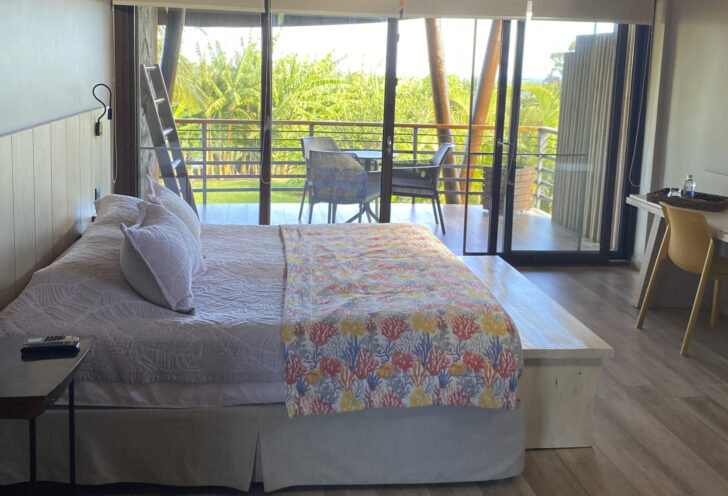
Now coming out of its first full season, this new hotel has a beautiful design and spacious comfy rooms, a modern style decoration with photographs and art throughout, beautiful plants inside and out, and a pleasant pool and outdoor seating area. It also has a dinner menu with some simple options. A stay here will give you more savings compared to the lodges or some of the other hotels. It definitely looks to be a place we’ll keep our eyes on.
The downside here is also the location, it is also located farther from town so you’ll need to arrange transportation to get in.
This is a good fit for travelers who want some savings and are ok with being located farther out of town. Ideally, you’ll be eating your dinners at the hotel, and would use a private guide to get out and see the island.
Hare Nua
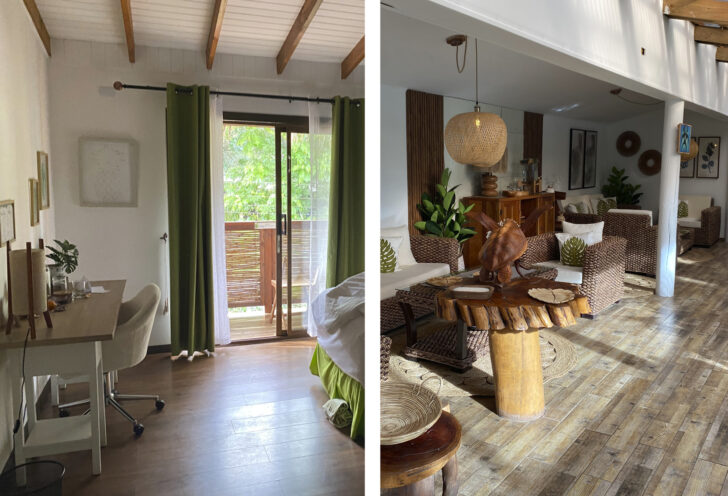
Hare Nua has friendly staff, colorful and fun interior decoration, and a cozy feel in the common areas. The property has little touches like a complete honesty bar, and a small pool and jacuzzi, all on-site. In total, it has 19 rooms across two categories. It’s very centrally located on the main street in Hanga Roa, so it’s easy to walk to the shore, restaurants, and shows. I spent a night here and made it out to a great restaurant and to a dance show, both of which were less than a five-minute walk away.
The downside? That central location means there is more noise around the hotel, mostly motorcycles, roosters, and dogs. It doesn’t have a restaurant. Breakfast service is simple, and space is limited. There’s no view here, but you are walking distance from the shore. It does offer some savings compared to some of these other choices, but not enough to be considered a budget hotel.
This is a good fit for a traveler looking for the playful decoration and one who wants to explore the town, restaurants, and shoreline on their own, and is not sensitive to the noise that goes along with that.
Taha Tai
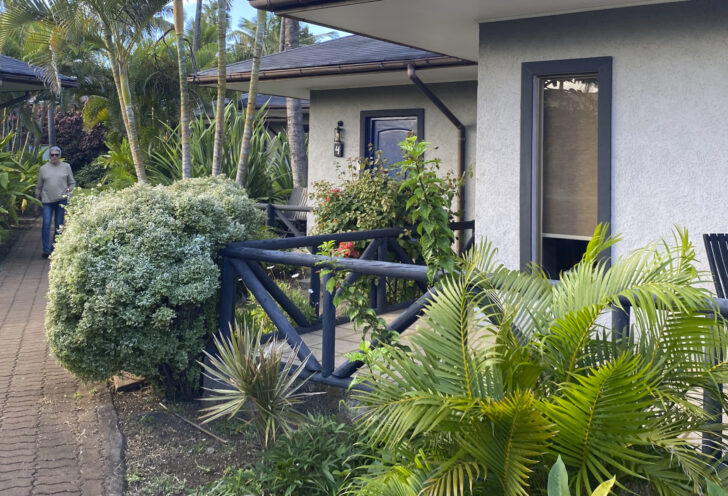
This hotel has a great location, just off the main drag and shorefront, but in a quieter area. When you walk in, it features a beautiful pool and entryway. This is a good option to keep the cost down. They have 10 bungalows, which are good for couples, have a bit more space and a little outdoor deck, as well as 30 standard rooms. It has a great on-site restaurant and breakfast offering.
The downside to this choice? These are smaller, simpler rooms; the decor is a bit dated, no there is no spa or seaview.
This is a good choice for a trip to the island on a tighter budget with a private guide and set excursions, as well as for travelers who are looking for opportunities to explore the town on their own.
Island Highlights
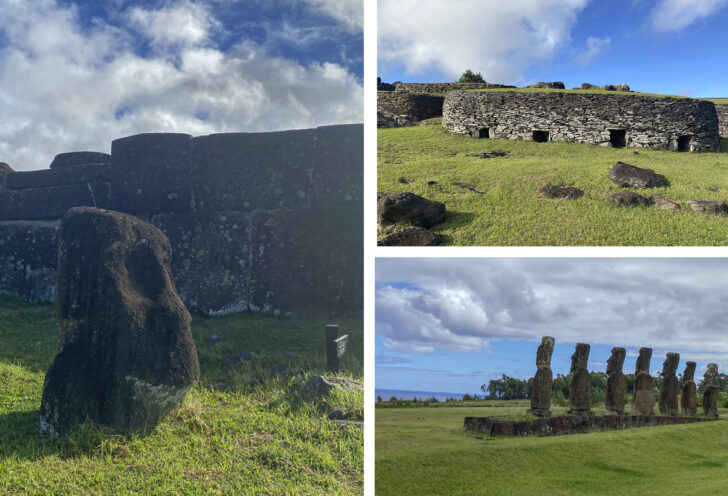
Exploring the history, culture, and geography of the island will take you to a range of different sites, and an enjoyable trip mixes in the Moai, craters, archaeological remains, and other geographical features in a series of half-day excursions. Nothing is particularly far away, but it’s best to prioritize based on geography and your interests. Here is a short list of things to do and see:
Tongariki
15 Moai stand with the sea behind; it’s one of the iconic spots of the island and the best place to view the sunrise. It was restored after the 1960 earthquake and tsunami. It pairs very well with Rano Raraku and is definitely a site where you can linger and take it in. I was able to make two trips here and didn’t regret it — a must-see.
Rano Raraku
This is the crater and quarry where many of the Moai were made. Here, you can see the process of the Moai, from the ones being cut out to those on their way to their intended destination, all strewn out in random places as if the artisans just dropped what they were doing and never came back. It’s an inevitable highlight of a visit, just an unreal and surprising setting. Also a must-see. I had clear days to take in the sea views, an added plus. Only one visit is allowed per pass.
Rano Kau
The most dramatic natural site on the island, a visible, well-defined crater with a lake on the inside. This has a lookout just off the road and also can be worked into a hike. It combines well with Orongo, which is located very close to the main lookout. I’d love to hike around this area whenever I make it back. Another must-see.
Orongo
Orongo is a ceremonial village and one of the more visited sites. Visitors can only go in once. There is some signage and story to complement the visit, especially about the Birdman competition to the little islands. The views from here are simply amazing, definitely a must-see.
Tahai
Just outside of Hanga Roa, this is the sunset spot. No pass needed to enter. Near the pier, shorefront area, and a smaller beach. It can also combine well with a visit to the caves. I stayed for a couple of sunsets here and enjoyed great people-watching as everyone sits back to witness the natural beauty of the golden hour.
Vinapu
Proof of Incan ties? This site points towards Peru and does look a lot like the Incan structures. It’s on a secluded side of the crater and pairs well with Rano Kau; a shorter, but still interesting visit. It’s even better if you’ve spent some time in Peru before.
Terevaka
This is the highest point of the island. It’s not a crater like the others, but offers beautiful views of the Pacific and the island. Visitors can hike, horseback ride, or bike as a half-day excursion to reach the top. A must for those who like mountain biking. The downhill is incredible — an absolute gem! A good example of one of the nice adventures to be had on a longer, four-night stay on the island.
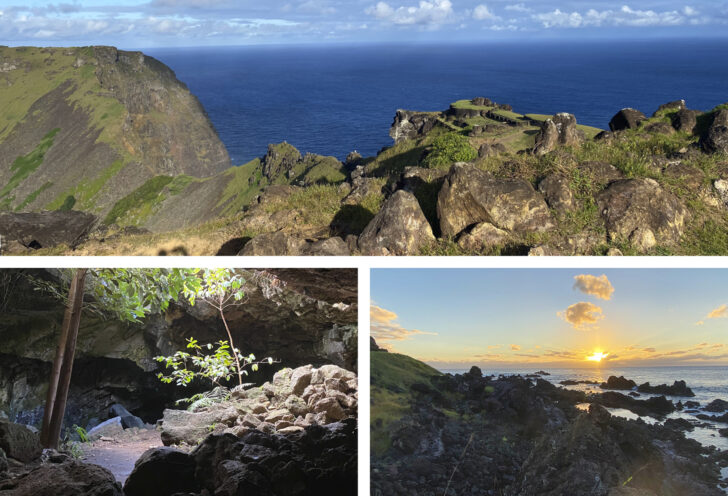
Roiho and Ana Te Pahu – Caves
A former village with some remains and a more lush area as you enter the larger cave systems. You can’t go far but it’s impressive, especially seeing the trees in open areas of the cave.
Ana Kakenga – Cave Portals
Located a bit north of Tahai, this can be a ride or a walk. These caves are small, tight passages you have to crawl through in order to enjoy the views. They open up to a portal view of the sea from the cliff. The landscape here is jagged and rough.
Anakena Beach
This is the best beach on the island, with white sands from the coral rock, palm trees, and a Moai site. It gets busier on the weekend but it’s a chill spot that is pleasing on the eye and relaxing. It has some places to eat and get drinks, with simple infrastructure. It’s tucked away from the main waves and tides.
Poike
This is the most remote crater on the far edge of the island. Always within view, but you need more time to visit it. It’s more of a rugged hike or ride and not as visited as the other sites, but possible to add on to some of the longer treks offered.
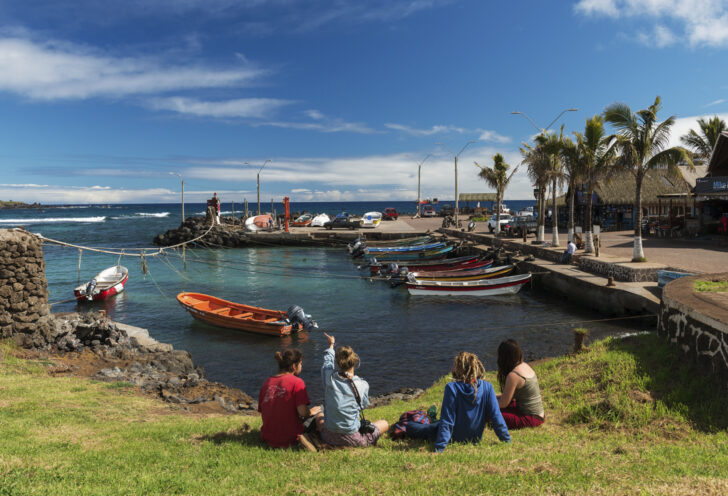
Other Activities
Stargazing is, at its core, an opportunity to capture astrophotography with the Moai and the stars.
Snorkeling, scuba diving, and bird watching are also popular options on the island, and can easily be added to your itinerary if you have extra time.
Easter Island Adds to Any Chile Trip
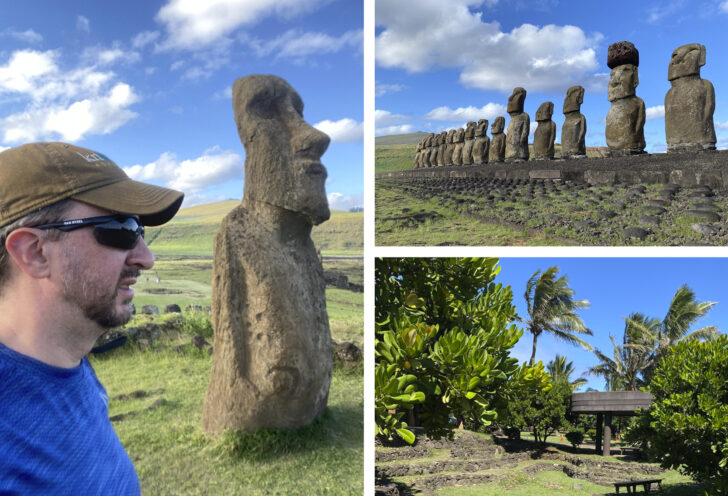
No matter how you combine Easter Island, it’s going to add something special to your trip. A unique, mysterious story, with these incredible stone statues as evidence of the past glory and certain strife. Craters, rocky volcanic shores, amazing sunrises, and captivating sunsets join together to create the beauty and mystery of Easter Island.
If you have any questions on travel to Easter Island or are interested in crafting a custom trip to Easter Island and beyond, reach out to me at [email protected] or 612-415-2894 ext 109.
 Colin is a Trip Specialist with Knowmad Adventures, a South American travel company that designs active, authentic, and sustainable journeys for independent travelers. Based in Santiago, Chile since 2004, this Iowa native has spent years exploring the country’s diverse landscapes, cultures, and hidden corners.
Colin is a Trip Specialist with Knowmad Adventures, a South American travel company that designs active, authentic, and sustainable journeys for independent travelers. Based in Santiago, Chile since 2004, this Iowa native has spent years exploring the country’s diverse landscapes, cultures, and hidden corners.

